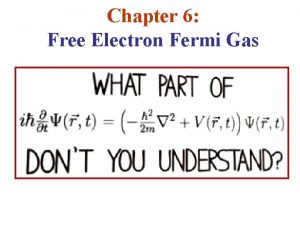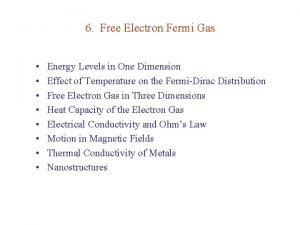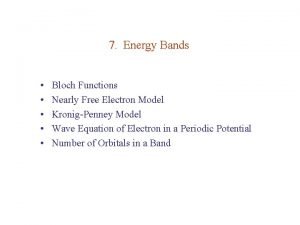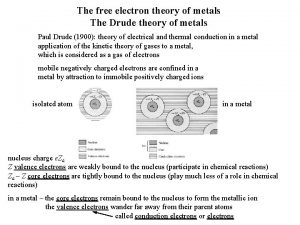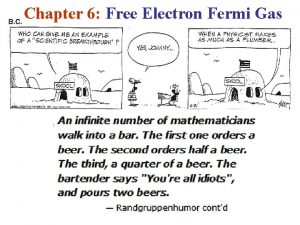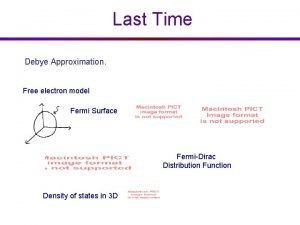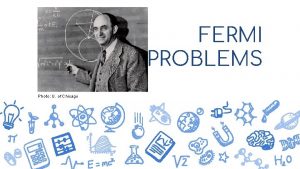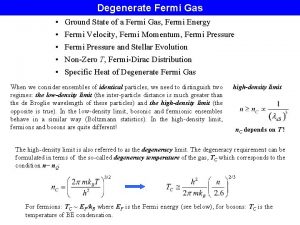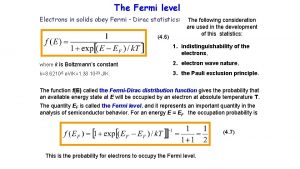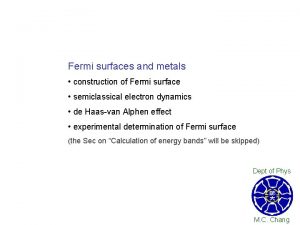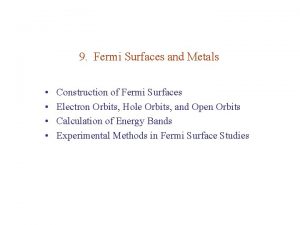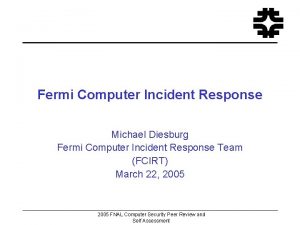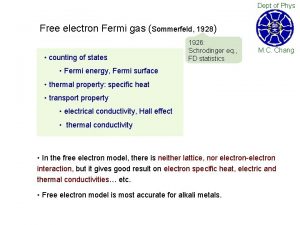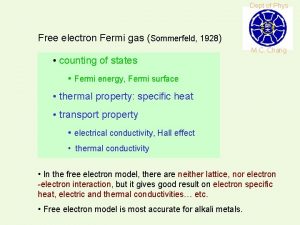Free Electron Model The free electron model Fermi





















- Slides: 21

Free Electron Model ØThe free electron model (Fermi gas) can also be used to calculate a pressure called the degeneracy pressure ØAs the Fermi gas is compressed, the energy of the electrons increases and positive pressure must be applied to compress it n This degenerate motion is forced on the electrons by quantum mechanics and it cannot be stopped by cooling the solid even to absolute zero 1

Ø The degeneracy pressure is given by Free Electron Model Ø For a typical metal this is Ø This enormous pressure is counteracted by the Coulomb attraction of the electrons to the positive ions 2

Free Electron Model Ø This degenerate pressure is important in stellar evolution n n Stars burn by fusion e. g. Ø For stars that are burning (fusion) the gas and radiation pressure supports the star against gravitational compression Ø When the star becomes primarily 12 C, 16 O or heavier the burning (fusion) stops and the star resumes gravitational collapse n The only barrier to this is the degeneracy pressure 3

Free Electron Model Ø The gravitational potential energy is calculated as 4

Free Electron Model Ø Then the gravitation pressure is Ø Which can be compared to our previous result for the degeneracy pressure 5

Free Electron Model Ø Once fusion ends, gravitational pressure causes the star to collapse until the gravitational pressure and degeneracy pressure balance Ø This happens at Ø Stars that reach this state are called white dwarfs n Most small and medium size stars (like our sun) end up as white dwarfs 6

Free Electron Model Ø White dwarfs have initial masses of M < 3 -4 Msun but radii on the order of Rearth! n We can calculate R using the results of our calculation Ø Or a teaspoon of white dwarf would weigh ~ 5 tons 7

Free Electron Model ØIf Mstar > ~1. 4 Msun, there are larger numbers of electrons with larger energies ØIf Ne is large enough, the electrons become relativistic and E≈pc instead of p 2/2 m ØThis changes the expression for the degeneracy pressure and in fact the gravitational pressure overcomes the degeneracy pressure and collapse continues 8

Free Electron Model Ø This further collapse causes Ø This means the star becomes a neutron star and now we calculate the degeneracy pressure using identical neutrons instead of identical electrons n For Mstar~2 Msun, equilibrium between the gravitational and degeneracy pressure can be reached and R ~ 10 km! Ø If Mstar > several Msun, there will be more neutrons and their energy will become relativistic n At this point there is no mechanism to counterbalance the huge gravitational pressure and a black hole is formed 9

Band Theory Ø The free electron model was successful in predicting a number of properties of metals n n n Conduction electrons had relatively long mean free paths l in order to gain agreement with experimental conductivity Electron-nucleus (ion) and electron-electron interactions were ignored The model isn’t appropriate for semiconductors or insulators 10

Band Theory Ø The free electron model was successful in predicting a number of properties of metals n n n Conduction electrons had to have relatively long mean free paths l in order to gain agreement with experimental conductivity Electron-nucleus (ion) and electron-electron interactions were ignored The model isn’t appropriate for semiconductors or insulators 11

Band Theory ØThere are striking differences between conductors and semiconductors n Recall R=ρL/A 12

Band Theory 13

Band Theory Ø Band theory incorporates the effects of electrons interacting with the crystal lattice n The interaction with a periodic lattice results in energy bands (grouped energy levels) with allowed and forbidden energy regions Ø There are two standard approaches to finding the energy levels n n Bring individual atoms together to form a solid Apply the Schrodinger equation to electrons moving in a periodic potential 14

Band Theory ØConsider first two atoms (say Na) n When the atoms are well separated there is little overlap between the electronic wave functions w The energy is two-fold degenerate n When the atoms are brought closer together, the electronic wavefunctions will overlap and we must use wavefunctions with the proper symmetry w As the two atoms move closer together the degeneracy is broken 15

Band Theory Ø The symmetric combination will be lower in energy because the ions exert a greater Coulomb attractive force 16

Band Theory ØEnergy levels of two atoms as they are brought close together 17

Band Theory ØConsider next six atoms n n n Again, as the atoms are brought closer togethere will be symmetric and antisymmetric wavefunctions But there will also be wavefunctions of mixed symmetry and the corresponding energies lie between the two Note the energy increases as the separation R becomes smaller because of the Coulomb repulsion of the ions 18

Band Theory ØEnergy levels of six atoms as they are brought close together 19

Band Theory ØEnergy levels of N atoms as they are brought close together – band formation 20

Band Theory Ø For higher (or lower) energy levels an energy gap may or may not exist depending on the type of atom, type of bonding, lattice spacing, and lattice structure 21
 Free electron fermi gas
Free electron fermi gas Free electron gas
Free electron gas Nearly free electron model
Nearly free electron model Electrical conductivity formula
Electrical conductivity formula Fermi gas model
Fermi gas model Hình ảnh bộ gõ cơ thể búng tay
Hình ảnh bộ gõ cơ thể búng tay Bổ thể
Bổ thể Tỉ lệ cơ thể trẻ em
Tỉ lệ cơ thể trẻ em Chó sói
Chó sói Tư thế worms-breton
Tư thế worms-breton Chúa sống lại
Chúa sống lại Các môn thể thao bắt đầu bằng tiếng bóng
Các môn thể thao bắt đầu bằng tiếng bóng Thế nào là hệ số cao nhất
Thế nào là hệ số cao nhất Các châu lục và đại dương trên thế giới
Các châu lục và đại dương trên thế giới Công thức tính thế năng
Công thức tính thế năng Trời xanh đây là của chúng ta thể thơ
Trời xanh đây là của chúng ta thể thơ Mật thư tọa độ 5x5
Mật thư tọa độ 5x5 Phép trừ bù
Phép trừ bù Phản ứng thế ankan
Phản ứng thế ankan Các châu lục và đại dương trên thế giới
Các châu lục và đại dương trên thế giới Thể thơ truyền thống
Thể thơ truyền thống
